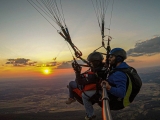It was one of those days when you don't know where to travel but fancy doing something different, so you think - why not explore Madrid's mountain range? Thus began our adventure, making the most of the weekend to experience adventure tourism while discovering villages we'd never visited before.
The villages winding through these slopes have the gift of resembling delicate brushstrokes, framed as if in an impressionist masterpiece. The richness concentrated in these lands goes beyond the ordinary. This is the jewel of Madrid province's northernmost region, though also its most forgotten. Fortunately, the recent surge in rural tourism has awakened this area for both locals and fortunate visitors alike.

With our provisions packed, we could do nothing but admire the beautiful scenery unfolding beyond our van's windows. I can assure you - in that moment, any sceptic's notion about Madrid's charm would have changed dramatically, realising their grave misconception.
We didn't want to miss a single detail of the spectacular landscapes unfolding with every passing kilometre. Our first destination would be Aoslos, a tiny hamlet (I stress, minute) 84km from Madrid, whose name derives from Celtic culture. This area was undoubtedly the main thoroughfare and remains the most representative in Madrid's territory. Millions of animals once migrated through here annually to winter in the plains and valleys of Talavera, Guadalupe and Almadén.
We quickly passed this curiously-named enclave, lying expectant beneath the blanket of clouds watching over us. Soon we reached Horcajo de la Sierra, nestled in the southern foothills of the Ayllón massif, part of Somosierra. Its name reflects the geographical nature of this place: "horcajo" means confluence of two rivers - here where the Madarquillos River meets its tributary, the Arroyo del Valle de Las Moreras.

Horcajo is among the area's earliest settlements; its hilltop location dominating the main route north suggests defensive purposes alongside livestock farming. One of its greatest treasures is the Church of Saint Peter in Cathedra, built in the 15th century as part of the Gothic movement. This single-nave church features a high choir, polygonal apse with exterior buttresses, and houses a 16th-century Gothic altarpiece with Flemish panels, a Saint Peter statue, and a tomb at the altar's foot.
Next destination: Horcajuelo de la Sierra at 1,145m altitude, nourished by numerous streams enabling orchards and grazing land. Visitors exploring this lattice of culture and cobbled streets - foundation of its beautiful houses - must see the Parish Church of Saint Nicholas of Bari, a Baroque construction with a 15th-century Gothic chapel, and the Ethnological Museum recreating a traditional rural dwelling plus typical costumes exhibition, complete with forge and art collection.

We stopped for lunch to savour local flavours, crowning our meal with excellent regional cheese. Perfection required only good coffee before continuing. Admiring the landscape's visual richness, we headed towards Montejo de la Sierra, our next stop. Leaving Horcajuelo, we noticed picnic areas by the town's encircling stream - perfect for al fresco dining.
Soon we reached Montejo de la Sierra, a hamlet of under 300 inhabitants reaching 2,000m altitude in places. This indicates mountainous terrain featuring extensive meadows, deciduous and coniferous forests. Beyond its oak groves (common throughout the region), it boasts the remarkable Montejo Beech Forest, also featuring oaks and holly trees.

Daylight was fading as clouds threatened to dim our overcast day's soft light. We decided to continue, ascending Puerto de La Hiruela - once part of Buitrago's Community of Town and Land, heading the Quarter of the Four Villages.
There at dusk, we marvelled at the surrounding sunset's beauty. Fresh air filled our lungs as the cold began biting at this altitude where we felt like kings of the world...











